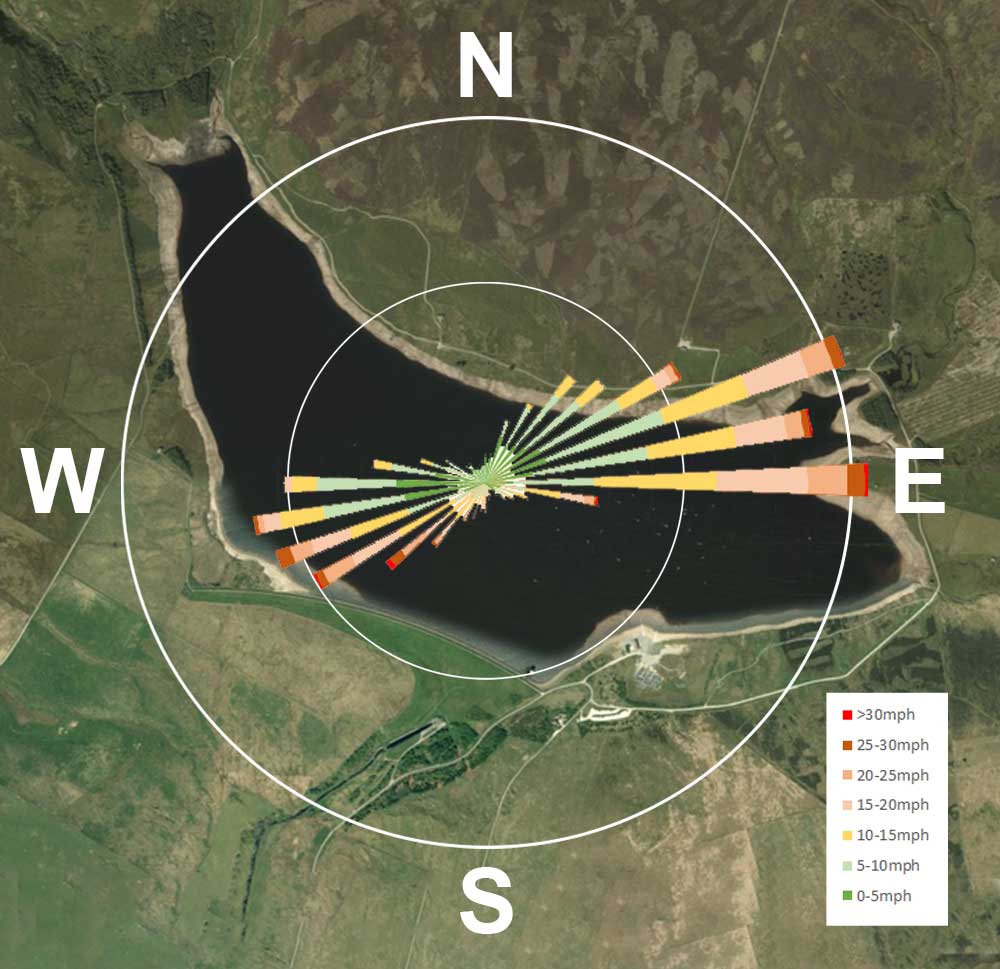For an inland venue, the wind at Grimwith is pretty steady. So if you’re in a 49er and its windy you’ll almost always be going for speed rather than taking the smaller shifts, but if you’re in a Topper, it will be worth working the shifts – even in a good breeze. As with most inland venues, being aware of what’s going on outside the boat is likely to win more places than having your head in the boat tweaking settings for pure speed.
The reservoir is quite deep, and there are no shallow patches away from the edge. It’s worth making sure you don’t miss the briefing though as any issues will be fully described then. At 1000’ high it can be a windy venue and so be prepared to rig accordingly – bring some spares – windsurfers bring your small sails!
Wind directions
Data from the YDSC weather station for the year to March 21 is shown below. It shows no. of readings by strength over the year.

The prevailing westerly is almost straight down the lake – just slightly over the dam. Upwind, it pays to checks which tack gusts are lifting and plan for the first shift accordingly. There are often Garda-esque increases in wind and a lift at the edges, but beware of getting caught too close to the dam if the wind is coming over it as there are lulls as well. Being in a position to take the shift is usually best, but when it’s windy, going for speed and hitting a lay line can work if the shifts are small, especially for fast skiffs etc. Offwind, there can be bands of added pressure – if so, find one and stay in it. Otherwise it’s a matter of playing shifts and working the gusts.
As the wind shifts round to the North-West, the first change from a westerly is the influence of the valley at that end of the lake. Gusts and added pressure are funnelled down the valley – spreading and increasingly lifting on starboard. As true North is approached that stops and it becomes more difficult to predict as lines of pressure appear off the northern shore and spread – lifting from either side. There will usually be a pattern, so best to check early or learn quickly! Downwind – it pays to take the best pressure as soon as you can – that’s especially helpful if it means gybing away from the shore.
Easterlies are usually very steady in direction, often with more pressure along one bank than the other. Playing small shifts is key, but if there’s any south in it, decent lifts on starboard may tempt the unwary into the clubhouse bank – looking for more gain but risking being left in a lull. While a starboard layline approach to the windwark mark may pay, be careful of the wind shadow caused by the old farmhouse – its some distance away, and not usually influential, but if the shadow is ‘on’ it will pay to avoid. Offwind it’s again a matter of finding the pressure and sailing low while in it, all the time watching for any new developing gusts – particularly along an edge. The northern shore will almost always be good while the southern may look good and tempt you in but then dump you.
The most difficult direction is a Southerly. It’s the least predictable – with comparatively big shifts and changes of pressure. There may be a pattern so as with the northerly, get out early and see if you can figure it out. In general, gusts are most likely to lift on starboard, so protecting that side may be key – just don’t bet on it too heavily. Offwind it’s vital to get into pressure early – look for it and try to be first into it – going high if need be.
So in summary, for an inland venue Grimwith has quite steady wind – especially from the west or east. In northerlies or Southerlies the wind is less steady, and its going to pay to prepare by checking out which side is lifting in gusts.
Above all it’s a great place to sail, and with often at least 5kts more wind than nearby lowland venues, you can almost always have a fun day on the water.

